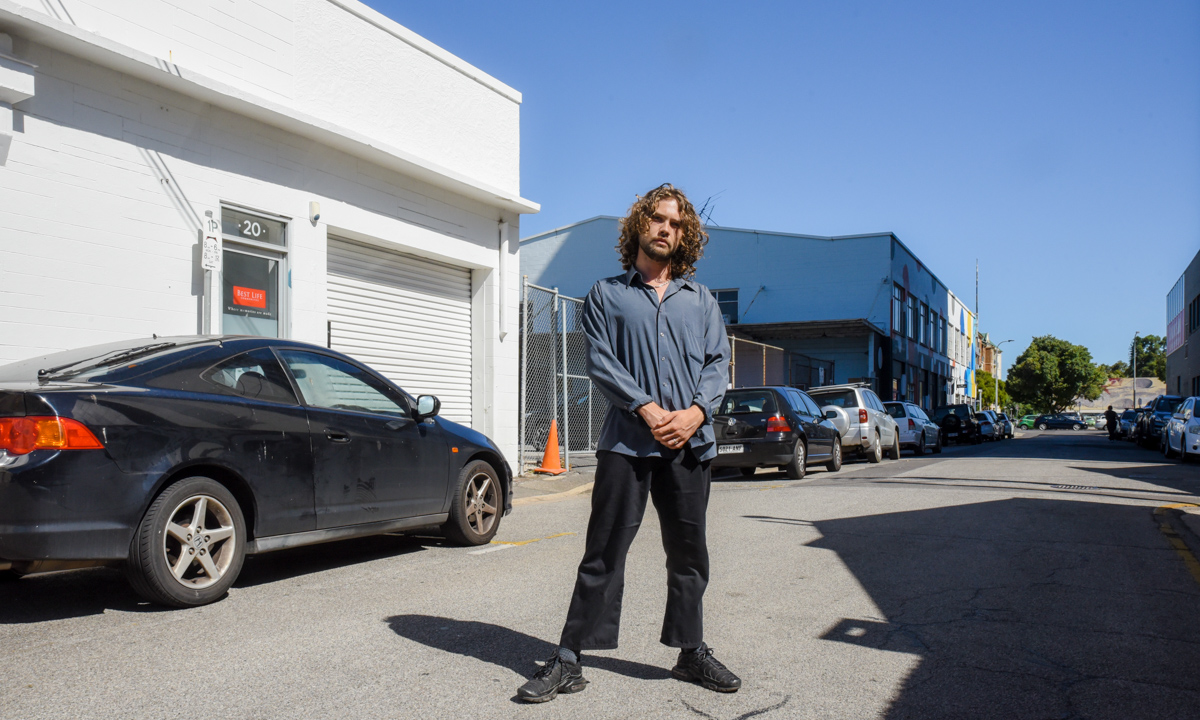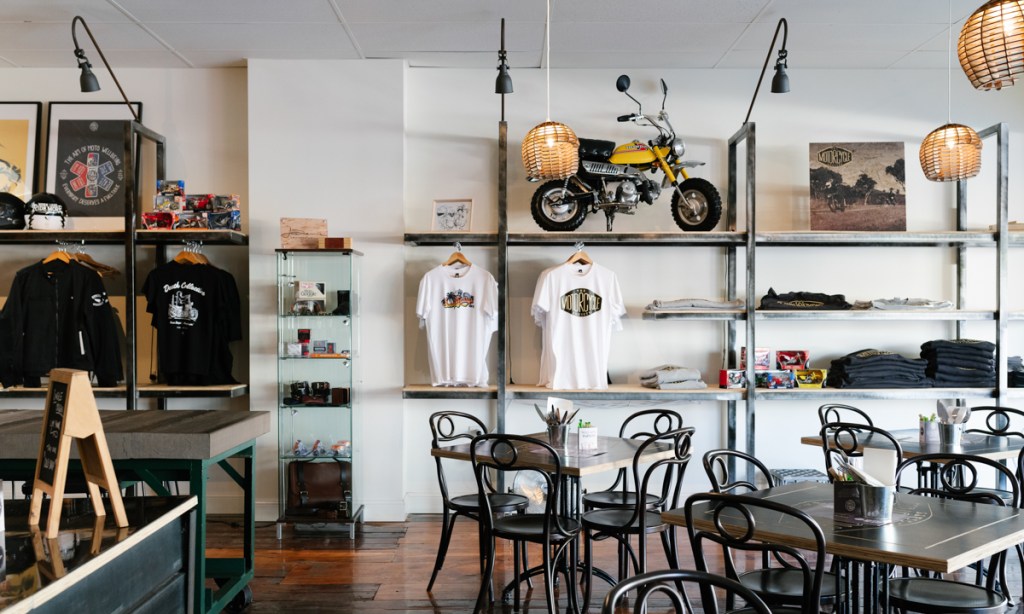An 18-storey retirement-living apartment set for construction on Gunson Street will force out a creative warehouse full of artists, photographers and fashion designers. We speak to current and former residents of the city laneway about what is lost when young people are moved on.
There goes the neighbourhood
A wisp of smoke lifts upward from the cigarette perched between Colby Robertson’s fingers, as we speak on the kerb of Gunson Street, outside Interim Studios.
The young musician and sound engineer, who has a mop of brown hair and wears black Nike TN trainers, has captured some of postcode 5000’s most exciting bands in the recording space.
Colby lets a puff of smoke out, which ascends across the massive monochromatic mural painted on Interim’s façade – an explosion of black and white splatter lovingly painted by visual artist Hari Koutlakis.
Across the road from the two-storey music studio — the largest purpose-built facility of its kind in the CBD, which Colby co-runs — is newly opened café and wine bar Dokeo. Further south down Gunson is multi-storey arts space The Mill, which has stood on its corner for 10 years and has been home to hundreds of emerging creators.
In the past, this tiny street has featured a range of off-kilter commercial tenants, spanning motorcycle mechanics to parkour athletes to fire twirlers. At its busiest, cross-pollination was rife and bled onto the pavement. Artists, musicians and grease monkeys would sit on milk crates and chat over coffee or beers. In 2017, it even hosted a mini-musical festival put on by Swirl Records.
New here? Sign up to receive the latest happenings from around our city, sent every Thursday afternoon.
Colby leads us inside the studio towards Interim’s control room, which is filled with guitars, cables and lamps. He’s been in the building five years, a portion of which was spent working for prior tenants Ghostnote Recording Studios. But for the past two years, he’s been the main occupant.

Colby Robertson
This article was first published in print in February 2023.
Since publishing, CityMag has been advised The Mill has extended its lease of the premises and taken on more leased area to accomodate 12 additional artist studios.
Colby tells us Gunson Street’s magic may soon be extinguished. There’s a new neighbour on the way – a towering apartment complex, slated for construction at the current site of The Mill.
“When retirement apartments go in, it’s, like, whether I’m being pessimistic or not, symbolically, it doesn’t feel good,” Colby says, pushing a curl behind his ear. “It doesn’t really inspire you to want to stick around.”
Late last year, the State Commission Assessment Panel — the group tasked with ticking or flicking building requests valued above $10 million — approved an application by Angus & Gunson Pty Ltd. As detailed in their submission, the developers plan to raze the existing warehouse and construct a new mixed-use building. Levels 1—3 will be retail and commercial tenancies, and 4—17 will contain 155 apartments for people over the age of 50.
The project is being spruiked as “affordable retirement living” by Best Life Communities, the business set to manage the site once developed. Best Life did not a respond to multiple calls and emails requesting comment for this story, but their website states the new complex is adjacent to the recently built private Calvary Wakefield Hospital, and is about community.
“Over 50’s lifestyle communities ensure you are surrounded by your peers in a secure, supportive setting,” the website says. “Social interaction and support are on your doorstep, and the Angas community has direct access to all the services of the city.”
Colby, and a growing group of street dwellers, are not happy. Not because of their new neighbours, but what this CBD building says about the city and state’s priorities.
“It’s not just an apartment complex; it’s retirement living,” he says. “That’s a very, very big demographic change. And that’s totally fine – nothing against retirees – but if you’ve got an entire area that’s serviced by an entirely different demographic, then it just feels like, what’s the point?”
Katrina Lazaroff is The Mill’s artistic director and CEO. She says when the warehouse-cum-creative-space was sold in 2021 to new owners, she was “quickly” made aware of their plans to re-develop. Although Katrina says the street’s best days are not over — “Good memories are fairly current,” she says — the street’s creative fabric may fray when construction starts.
“Once the development is complete a community of retirees will certainly bring a different vibe than the diverse array of artists and audiences who attend and reside at The Mill,” Katrina says.

The Mill’s frontage on Angas Street
Patch Theatre — a 50-year-old local theatre company performing for children — has occupied an office within The Mill since 2018. Although general manager Penny Camens says Patch is currently consolidating into its new location in Kent Town, which will be a joint storage, rehearsal and office space, she says the “sad reality” is “many of the state’s premier arts organisations are based in buildings flagged for redevelopment”. “They lack a purpose-built space,” she says.
This sentiment is shared by photographer Morgan Sette, who has worked within The Mill for six years in varying capacities. For the last two of those years, she’s been the main leaseholder in Upstairs Studio – a co-working space currently occupied by a range of creatives, including fashion designers, music publicists and other freelancers.
Morgan says she was initially attracted to The Mill because the place was cheap and came with a naturally lit studio. Although she has built a sturdy career for herself – with her photojournalism published by News Corp Australia, AAP and CityMag – Morgan is concerned for up-and-coming photographers who may be priced out of certain properties.

Morgan Sette. This picture: Daniel Purvis
“When I was looking for a warehouse a couple of years ago, with a bunch of other artists not connected to The Mill, I wasn’t finding anywhere within five kilometres of the city less than $65—80,000-plus, per year,” she explains.
“And they were all dilapidated warehouses that were submitted for [development] approval within the next few years, so it was kind of like that’s the only option available for people trying to contribute towards culture here.
“We should stop making apartments in the city so much more accessible to the Boomer category.”
Morgan says if The Mill were to leave its current site to make way for a retirement-living apartment complex, it would be a “condemnation of the street”.
Peter Zammit, of The Motorcycle Society, fled the area in June 2021 — well before the vertical retirement village’s plans were formally approved. He tells us it was a combination of exorbitant rent and the behaviour of the Adelaide City Council that inspired the move.
Peter alleges that during a routine visit from a council employee in December 2021, he was encouraged to leave. Peter says the council had been hassling him regarding the impact his bikes were having on the visual amenity of the street, and a council employee “basically told us that we should just move [and] it was only going to get worse”.
CityMag approached the Adelaide City Council for comment on these allegations, but they did not respond.

The Motorcycle Society’s original Pirie Street site. This picture: Josh Geelen
The Motorcycle Society, now located in Mile End, sublets a space from The Muscle Car Shop. Both businesses share an affection for fast things, but Peter occasionally misses his old neighbourhood, where the veteran mechanic would grab a bite to eat from nearby Iranian restaurant Naaz Persian Cuisine, or a Greek treat from Diaspora Kouzina.
“The social side of the street died very quickly — not just because of COVID, but then when these new buildings came up, that was the end of it,” Peter says. “That’s why we left.”
Point A Movement, a parkour, acrobatics and physical exercise gym, was nestled on Gunson Street for eight years. This business was forced out of the street in 2021 when the building was purchased by new owners. Although Point A owner Travis Ranson did not respond to our emailed questions, the business’s website says they were “evicted” to make way for “apartments”.
University of South Australia professor of cultural economy, Justin O’Connor, sees changes like this in self-contained communities within the city as more than “gentrification”. That term, he says, is “almost too quaint to describe what’s going on”.
Gentrification is usually deployed to describe the process of middle-class people purchasing housing stock in working-class areas, but Justin says “huge levels of capital” are moving into cities.
“After the [global financial crisis], in the last 10—15 years, something changed in that there was this idea to get artists in, make it a bit trendy, and then higher value uses come after that,” Justin explains. “That was the usual narrative. That’s gone.”
Now, developers can afford to build anywhere – not just the “dirty spaces you find across the spectrum of art,” Justin says – and they are pumping out buildings that reap the highest rewards: usually a mix of retail and accommodation.
Justin’s academic focus is the relationship between culture and economy, and he’s studied urban regeneration since living in Manchester in the 1990s. In the UK, the music scene of that era breathed new life into the former textile neighbourhood.
Factory Records famously ran nightclub The Haçienda within the guts of a former yacht builder’s shop and warehouse, from which bands such as Joy Division and the Buzzcocks laid a foundation that allowed Oasis and The Stone Roses to springboard onto a global stage.
When we ask Justin if there are lessons for Adelaide in Manchester’s story, he says development toppling culture is a phenomenon occurring globally — and it has devastating effects.
“The idea that governments can sit back and hold things for private developers and let the market decide is destroying cities,” Justin says. “We know that from London, that from Berlin, places like Amsterdam. It’s really difficult to put a city back together once you’ve let global capital come into the city.”

Best Life is moving in
Late last year, the State Government rolled out its New State of Mind campaign – a sleek series of online, television and social media advertisements aimed at selling South Australia as a “diverse, progressive, sustainable and innovative state”. Its intention is to bring outside talent into SA
Justin is sceptical of the campaign’s long-term success.
“What on earth do you think people, all these bright young things, will do when they get to Adelaide?” he says.
When we ask Arts Minister Andrea Michaels about the campaign’s cost and its metrics for success, she did not respond. But she says off the back of the Santos Tour Down Under bicycle race and Mad March, Adelaide is “absolutely buzzing”.
The minister also did not respond to direct questions about whether The Mill’s replacement with retirement living aligns with the government’s priorities.
At the very least, Justin believes the impending project “screams not so much the bad priorities of Adelaide, but the complete lack of thinking”.
When we ask Ilia Houridis, the Adelaide City Council’s director of city shaping, how the council balances development and culture, he says the council aims to support both.
“Our city’s Park Lands, cultural and heritage buildings, University precincts and pipeline of new development brings with it a mix of growth and new residential opportunities that include social and affordable, high-end residential and downsizing and retirement – which speaks to the diversity of citizens we have in the city and North Adelaide,” Ilia says.
Back at Interim, Colby says he knows he has no real power in this situation. The nearby development has been approved and will most likely go up. The street will be forever transformed. Future residents of the building might issue noise complaints, or ask the council to clean up the visual amenity of the street by removing the milk crates and other artefacts of daily life.
We ask Colby if he’ll contest this project, or ask the Adelaide City Council to review its planning laws or priorities for the city.
He looks us in the eye, and says, defeatedly, “What am I going to ask?”





